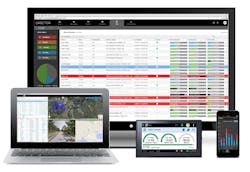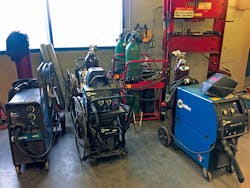Third-party Telematics Distill Diverse Data
“Data” may be the word of the decade across many industries, but to many heavy equipment asset managers the word connotes something that can be as inscrutable as the most difficult New York Times crossword puzzles.
Most pieces of late-model equipment contain telematics hardware and software producing a massive string of data, fault codes, and the like, and managers often have to visit multiple OEM websites to gather and interpret the information. And if a fleet is made up of iron from different manufacturers, it can be problematic to pinpoint trends, problems, and costs that affect the fleet and business as a whole.
This is where third-party telematics providers come in. Systems from the so-called “black box” makers have a number of advantages.
For one, they allow tracking of ancillary assets that usually do not have telematics capabilities embedded by a manufacturer, such as trailers, light towers, arrow boards, generators, and compressors. There are numerous on-road advantages for pickups and other trucks as well, including monitoring driver behavior, more accurate logs and maintenance records, wear prevention, streamlined routing and dispatch, accident investigation, possible insurance savings, and more.
But where third-party providers shine the most is in helping those mixed fleets.
A typical case is Sherwood Construction, a Wichita, Kansas-based heavy highway contractor with operations spread across four states and a mixed fleet of more than 500 units. Sherwood wanted to consolidate data from all of its equipment OEMs into one place.
Doug King, CEM, corporate equipment manager for Sherwood, and his staff, had to visit multiple manufacturer sites to view data, including portals from Caterpillar, John Deere, Volvo, and Komatsu. There was plenty of data, but it was reported in different formats and it did not give Sherwood the fleet-wide view it desired.
Sherwood used a suite of solutions for construction from third-party provider Teletrac Navman, which follows the ISO telematics standard to aggregate all the data into a single interface. King and his equipment and trucking superintendents, regional managers, shop foremen, and field service coordinator can view machine locations, service meters, hours, and idling versus production time.
“What really pushes you to telematics is the data,” King says. “The data you can gather is just amazing.”
The real-time location data from GPS tracking has helped make maintenance more efficient by ensuring technicians are able to service all the equipment with needs in a given area. It has also enabled the company to better track maintenance, which is one of the fleet’s biggest expenses. The immediate data from service meters is much more accurate than paper logs, and King says the data ensures undercarriage checks are timely.
There have been effects on planning and bidding, as well. With aggregated OEM data, it has been easier for Sherwood to gauge the efficiency of entire jobs. For one job, the company was able to measure ADTs’ cycle times and compare them to the trucks’ onboard scale systems. By making that comparison, the company was able to see that the site was operating efficiently, leading to more accurate bidding and proper staffing for future jobs.
The GPS tracking also helped Sherwood recover stolen equipment. It led police to the exact barn where a stolen backhoe loader was stashed, and also aided in finding a stolen skid steer. The two pieces would have cost more than $160,000 to replace, King says, and the recovery of just one of them by itself could have paid for the entire technology system. And that’s not counting the value of operational and efficiency gains.
There are a number of third-party providers for managers to consider. Following is a look at some of their offerings, including examples of hardware, overall capabilities, and software.
Technology provider HCSS offers four pieces of telematics hardware to collect data. Its OBD-II unit is a plug-in unit for pickups and fleet vehicles. A wired unit for heavy equipment comes with a weather-resistant case, and provides remote monitoring of meter readings, mileage, operator behavior, and peripherals.
The satellite asset tracker is a battery-powered tracker for nondriveable or nonpowered assets, and provides reports on unauthorized movement and engine run time. Data can be retrieved from remote locations via satellite.
The company’s Geometris heavy equipment GPS unit plugs into a standard 9-pin connector and is designed specifically for heavy equipment. HCSS says the box is resistant to high reverberation, can support a high voltage, and installs in less than 30 seconds.
To interface with existing OEM telematics, HCSS has OEM Link, which automatically pulls John Deere, Caterpillar, Volvo, and Komatsu telematics data into its telematics system so OEM data can be seen in one place.
Verizon Connect is the rebranded result of consolidation among Fleetmatics, Telogis, and Verizon Telematics. It says its data-driven solutions help create a safer work environment for construction businesses with tools to analyze operations and head off accidents that cause project delays, productivity losses, and increases in insurance premiums and incident-related paperwork.
Verified paperless inspections are available to ensure that all assets are in optimum condition. Managers can also employ the ISO standard and alert teams to equipment issues before they become safety hazards.
Verizon also touts its equipment location and usage tracking features’ abilities to account for expenses, enhance the ability to anticipate job costs, and calculate operating margin, helping the bidding process. A streamlined reporting process is meant to save the time of working through intricate systems. The system is also designed to work for rented equipment in remote locations.
In addition, it addresses the opportunity to claim back fuel taxes fleets may be entitled to from operating vehicles and equipment on private roads and job sites.
Proving off-road fuel consumption can be challenging, but Verizon Connect says its reporting can automatically track miles driven or engine hours for off-highway vehicles and combine the data with fuel used to make claiming a tax refund easier. Other key features include the ability to check advanced diagnostic sensors to detect vehicle misuse, such as excessive engine loads, as well as the opportunity to monitor payload capacity to ensure full vehicle utilization, minimize unnecessary trips and rework, and keep loads within legal limits.
Orbcomm’s FleetEdge product, perhaps best known in the mining equipment sector, is designed to provide heavy-equipment managers access to location data and operational status, as well as analytic, predictive, and diagnostic tools for every asset in their fleet.
The data is transmitted to the FleetEdge system by tracking devices via Orbcomm’s multiple satellite or cellular networks for complete asset visibility and control. The Orbcomm mobile app is available to view and manage data on the go.
Specifically, the system allows managers to track engine hours, access position/mileage/fuel reports, sensor alerts, use geofences, fault codes, and help prevent unauthorized use and theft. On the maintenance front, PMs can be improved with the creation of maintenance logs and the planning of repairs.
Also, with complete fleet visibility and real-time data, it’s possible to lower lifecycle costs, increase ROI, and optimize billing practices, Orbcomm says. And its Remote Dashboard lets users view engine and chassis sensor reports in near-real-time, wirelessly on site or in remote areas of the world.
Geotab markets the IP67-rated Go Rugged telematics device to track heavy equipment and powered trailers and assets. It’s designed for harsh conditions or external installation. It offers visibility and dashboard reports of workforce, assets, and costs, and allows managers to track fuel usage and idling trends. The unit also monitors engine hours and PTO usage. An open platform is meant to provide easy data integration and facilitate marketplace apps and add-ons.
Zonar makes the ZTrak equipment tracker, which is designed to manage zero and low-maintenance assets that are deployed for long periods. A web-based asset- management portal has location reports available with a few clicks.
For an RFID-powered equipment-tracking alternative, OEM Data Delivery makes a number of devices, and the company touts their low cost. The upfront cost of passive and active RFID tracking solutions is offset by the long lifecycle and re-usability of the components, it says. RFID can also take advantage of existing networking solutions, such as Wi-Fi systems.
OEM Data says the security strengths of RFID systems are two-fold. First, RFID tracking solutions can be programmed for specific project requirements, making them adaptable for a variety of conditions. Second, RFID systems not only allow a manager to track equipment usage, but they also help to keep machines secure by implementing an RFID tracking solution.

